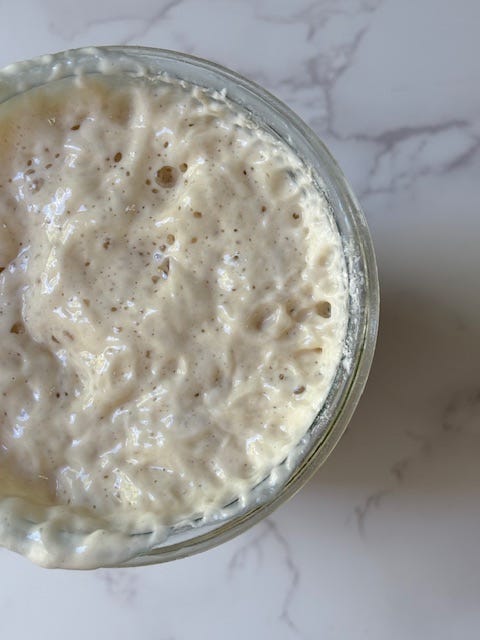Hi beloved friends. Wow what a weekend I had. I had my first market that I’ve done in awhile and it was my first big bake in my new bread oven. So many things went right, and so many things went wrong - I am planning to share all these “things” in a later post, but today I wanted to talk about sourdough starter and feeding ratios - one of the biggest challenges for most beginner bakers.
So let’s get started shall we?
As you probably know by now, your sourdough starter is ALIVE - it's an active culture of wild yeast and bacteria. And guess what? Just like you and I, your sourdough starter needs food.


A sourdough starter needs a regular "feeding" of fresh flour and water in order for the wild yeast and bacteria to continue to function.
So, you might be asking…. how much food should you feed your sourdough starter?
Let’s break it down…
You want to use a feeding ratio when feeding your sourdough starter. All this means is the proportion of starter to flour and water.
Example: a 1:2:2 ratio = the first number in the ratio is the amount of starter, the second number is the amount of flour and the third is the amount of water. So for this example you are feeding two parts flour and water to one part starter.
MINIMUM FEEDING:
1:1:1 ratio. Which means however much starter you keep by weight, you will want to feed it equal amounts of flour and water by weight. Example: if you have 25 grams of starter, you'll feed it 25 grams of water and 25 grams of flour. This fresh flour and water is not only food for the starter that you already had, but it is also now a part of that culture you've just created. For this example, you'll have about 75 grams of starter.
I don’t recommend feeding your starter a 1:1:1 very often because the wild yeast and bacteria will go through the food quickly and this causes a lot of lactic acid in your starter, potentially making it less healthy. But in a pinch when you need your starter to be ready quickly, this is a good ratio.
OTHER FEEDING RATIOS:
Aside from the 1:1:1 feeding ratio, there are many other ratios that are commonly used. You might see some bakers using a 1:2:2 or a 1:3:3 or even a 1:4:4 or 1:5:5. Again, all this means is the amount of food you are feeding in comparison to your sourdough starter.
I typically use a 1:3:3 ratio meaning that however much starter I have, I feed it 3xs the amount of flour and water. So let’s use our example again of keeping 25 grams of starter. For the 1:2:2 feeding, you would give your starter 75 grams of flour and 75 grams of water resulting in about 175 grams of total starter.
So why would you need or want to adjust your starter ratio? Simple, to manipulate how long it will take to rise and fall.
My favorite way to think about it is to imagine my sourdough starter as little tiny people who are very hungry (or HANGRY), if you feed them less food then they will eat through it faster, resulting in a quicker rise. If you feed them more food, it will take them longer to eat it all. So if you're ever in a situation where you need your starter to rise faster, feed it less (a 1:1:1 ratio), if you need it to ferment slower, feed it more (a 1:3:3 or even 1:4:4 ratio).
Make sense?
You can also use the ratio to your advantage through the seasons. Remember, during warm (or hot) months (like the ones coming up soon!), your sourdough starter will rise faster, so you can decrease the amount of ripe starter added to the jar - more ripe starter equals faster ripening time. (To put it simply, just feed it more!).
And now for that irresistible Sourdough Chocolate Chip Cookie Recipe I promised…
Keep reading with a 7-day free trial
Subscribe to The Crumb Diaries to keep reading this post and get 7 days of free access to the full post archives.



